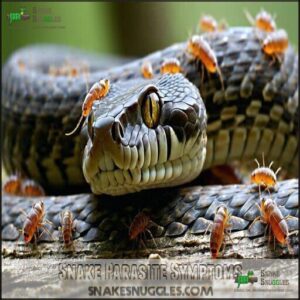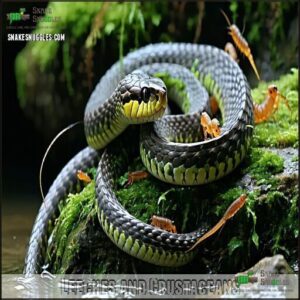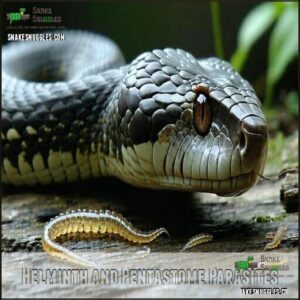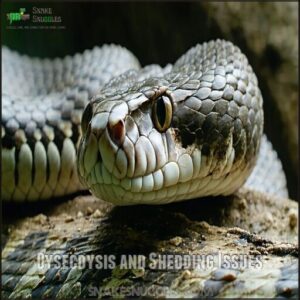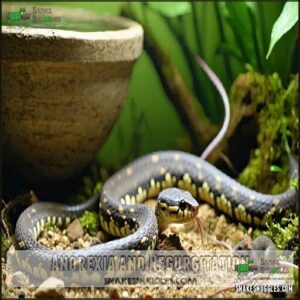This site is supported by our readers. We may earn a commission, at no cost to you, if you purchase through links.
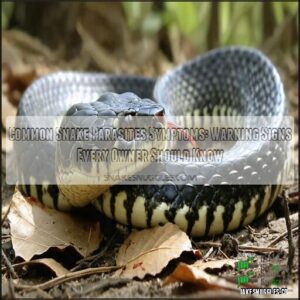 Spotting common snake parasites symptoms early makes all the difference in keeping your scaly friend healthy.
Spotting common snake parasites symptoms early makes all the difference in keeping your scaly friend healthy.
Watch for signs like unexplained weight loss, anemia (pale mouth or gums), and persistent failure to shed properly—it’s like a red flag waving.
Skin may show lesions or infections, while respiratory issues like wheezing or open-mouthed breathing could signal trouble.
Don’t ignore behavioral changes either, like anorexia or regurgitation after meals.
Parasites such as mites, ticks, and worms are the usual suspects, often hiding in plain sight.
Acting quickly and consulting a vet can save your snake a lot of discomfort.
Prevention? That’s another story.
Table Of Contents
- Key Takeaways
- Snake Parasite Symptoms
- Common Snake Parasites
- Parasite Infection Signs
- Reptile Parasite Prevention
- Diagnosing Snake Parasites
- Frequently Asked Questions (FAQs)
- How do I know if my snake has parasites?
- What are the symptoms of parasites in reptiles?
- What are three symptoms of a parasite infection?
- Can snake parasites affect reproductive success?
- How do parasites impact snake behavior?
- Are there seasonal patterns in snake parasite prevalence?
- What environmental factors increase risk of parasite infestation?
- Do parasites influence snake interactions with prey or predators?
- Conclusion
Key Takeaways
- Keep an eye out for symptoms like weight loss, anemia, respiratory issues, and shedding problems, as these are common signs of parasites in snakes.
- Parasites like mites, ticks, and serious health issues can cause problems, so act fast with proper treatment to prevent complications.
- Maintain a clean environment, practice daily waste removal, and quarantine new snakes to reduce the risk of infestations.
- Schedule regular vet checkups to catch parasites early and use vet-approved medications for effective treatment.
Snake Parasite Symptoms
If your snake’s behavior seems off or it’s showing signs like weight loss or breathing trouble, parasites might be the culprit.
Parasites may be the hidden cause if your snake shows unusual behavior, sudden weight loss, or trouble breathing.
Recognizing these symptoms early can help you take action before the problem worsens.
Anemia and Weight Loss
Anemia and weight loss in snakes often stem from blood parasites, internal snake parasites, or external ones like mites and ticks.
Nutritional deficiencies from organ damage or metabolic disorders further worsen these snake parasites symptoms.
Watch for lethargy, immune suppression, or dramatic weight loss as major snake worm signs. Spot changes fast—these may indicate internal trouble needing vet care pronto.
Skin Lesions and Infections
Watch out for skin changes! Snake parasites symptoms like mites or acariasis can lead to bacterial infections, scale rot, and even abscess formation.
Snake mite infestation may cause Blister Disease, leaving your snake’s skin rough or discolored. Ectoparasites aggravate these conditions, making quick treatment essential.
Keep enclosures clean to prevent fungal diseases or worsening infections from parasites hiding in crevices, as quick treatment is essential to prevent further complications, and maintaining cleanliness is crucial for preventing bacterial infections.
Respiratory Issues and Pneumonia
Trouble breathing? That’s a big red flag. Parasites can trigger respiratory signs like wheezing due to larval migration in the lungs.
Left untreated, lung damage can lead to pneumonia. Watch for three symptoms:
- Frequent breathing difficulty or gasping.
- Mucus discharge from nostrils.
- Lethargy and wobbling.
Secondary infections worsen these snake health problems. Environmental factors can also contribute to these issues, learn more at Environmental factors. Seek pneumonia treatment immediately!
Common Snake Parasites
Snakes can host a variety of parasites, from mites and ticks on their skin to worms and protozoa in their organs.
Understanding these common parasites helps you spot potential problems early and keep your pet healthy.
Mites and Ticks
Mites and ticks are frustrating ectoparasites for snakes. Mites like Ophionyssus natricis hide in skin folds, causing itching, reduced health, and shedding problems. Severe infestations may even lead to anemia.
Quick identification, Acariasis treatment, and consistent environmental control prevent transmission vectors. Regular fecal examinations aid in early parasite detection.
Check the table below for key details:
| Parasite | Symptoms | Treatment |
|---|---|---|
| Mites | Shedding issues, anemia | Permethrin, ivermectin |
| Ticks | Paralysis, infections | Manual removal, permethrin |
Ticks, on the other hand, can induce paralysis and spread diseases through bites.
Leeches and Crustaceans
Leeches and crustaceans are troublesome external snake parasites.
Leeches, often found on aquatic snakes, cause anemia, weight loss, and infections, but Leech Removal is simple.
Crustaceans like barnacles attach to skin, leading to Crustacean Osteolysis or Aquatic Infestations.
Prevent infestations by avoiding contaminated water and maintaining a clean environment, as both ectoparasites can pose Zoonotic Potential, so early detection is vital.
Helminth and Pentastome Parasites
If leeches and crustaceans crawling on your snakes weren’t alarming enough, helminths like nematodes and pentastomes wreak havoc internally.
These snake parasites cause serious symptoms:
- Respiratory problems from pentastome risks and nematode issues.
- Trematode infections impacting digestion or lungs.
- Ascarid effects like abdominal masses.
- Ineffective tapeworm treatment leads to persistent shedding.
Act quickly—these parasites don’t wait.
Parasite Infection Signs
When your snake isn’t acting like its usual self, parasites might be the hidden culprits behind the change.
From shedding problems to appetite loss and even paralysis, these signs can offer critical clues to an underlying infection.
Dysecdysis and Shedding Issues
Parasites can disrupt shedding frequency, leading to dysecdysis—patchy, incomplete sheds.
Watch for retained spectacles or skin damage, signs of poor humidity levels or nutritional deficiencies tied to snake parasite infections.
Mites hide in scales, making your snake uncomfortable, which harms its health.
If shedding issues continue, it’s a sick snake sign worth checking for snake common diseases.
Anorexia and Regurgitation
When snake parasites wreak havoc, you might notice anorexia or regurgitation after meals—common snake symptoms tied to digestive blockage, gastric ulcers, or protozoal infection.
Stress impacts digestive health too, making parasites harder to detect, and heavy ascarid impaction may worsen these snake diseases.
If your snake’s appetite vanishes or food comes back up, it’s time for a vet visit to address potential issues like digestive blockage.
Muscle Degeneration and Paralysis
Tick paralysis can leave snakes limp, as ticks damage muscles at the bite site.
Heavy infestations of nematodes or pentastomes also cause degeneration, leading to weakness.
While muscle damage isn’t always obvious, watch for mid-body swelling or sluggish movement—classic snake parasite symptoms.
Prompt ivermectin treatment tackles snake diseases like these, protecting against further degeneration.
Prevention’s key and should be considered to avoid such issues, and prompt action can save a snake’s life.
Reptile Parasite Prevention
Preventing parasites in snakes starts with good habits like quarantining new additions and keeping their habitat spotless.
Preventing parasites begins with clean habitats, vigilant care, and quarantine—protect your snake’s health with proactive, daily habits.
You’ll also need to watch for early signs and use medications when necessary to keep your snake healthy and parasite-free.
Quarantine and Screening
For new arrivals, isolation protocols are key to snake parasite prevention.
Quarantine your snake for 30-90 days to monitor for health issues, including reptile parasites.
Use preventative treatments like ivermectin, and practice environmental control to stop outbreaks.
Early snake parasite diagnosis helps avoid zoonotic potential.
Think of quarantine as your first defense line—it’s a must for healthy collections!
Maintaining proper temperature gradients can also aid in preventing illness during this stressful period.
It is crucial to consider quarantine as an essential step in maintaining the health of your snake collection.
Environmental Sanitation
Keeping your snake’s enclosure spotless isn’t just about pride—it’s about their health.
Parasite control starts with habitat hygiene.
Here’s how:
- Perform regular terrarium cleaning.
- Practice daily waste removal.
- Use reptile-safe disinfectants.
- Choose clean, replaceable substrate.
- Avoid overcrowding to lower contamination.
A cleaner environment lowers snake parasite risk, keeping your reptile happy and your worries small.
Medications and Treatments
Treating snake parasites often involves medications like ivermectin (dosage must be veterinarian-approved) for mites or ticks and praziquantel use for tapeworms.
Antiprotozoal drugs tackle infections like Cryptosporidium, but supportive therapies, such as hydration, are critical.
Severe cases may need surgical interventions or specialized snake vet care.
Always pair parasite treatment with regular checkups for effective and safe reptile parasite treatment.
Some snakes may also suffer from cutaneous myiasis caused by bot flies.
Diagnosing Snake Parasites
You’ll need a keen eye and proper tools to spot the early signs of parasites in snakes.
Through physical exams and specialized techniques like endoscopy, you can identify infections accurately and guarantee your snake gets the right care, which is crucial for providing the right care.
Physical Exams and Observations
Spotting snake parasites starts with observation. Subtle behavior changes, like reduced activity or frequent soaking, can signal issues.
Use a visual inspection to check for ectoparasites or skin lesions. Palpation techniques help detect internal abnormalities, while a fecal examination reveals microscopic threats.
Regular vet checkups are essential for prevention. Watch for clinical signs like rough scales or abnormal stool—your snake’s health relies on keen observation!
- Visible ectoparasites: Inspect skin folds, eyes, and vent.
- Palpation cues: Feel for lumps or tenderness.
- Fecal insights: Detect hidden parasite eggs.
Endoscopic Removal and Treatment
Removing internal parasites like pentastomes often requires endoscopy under anesthesia protocols.
It’s effective for snake parasite treatment but has scope limitations if parasites are small or numerous.
Surgical alternatives may be needed in severe cases.
Endoscope tools aid in diagnosis.
Post-op care guarantees recovery.
| Procedure | Effectiveness | Risks | Recovery |
|---|---|---|---|
| Endoscopy | High for pentastomes | Anesthesia, infection | Moderate |
| Surgery | Extensive | Higher trauma | Longer |
| Antihelminthic drugs | Temporary relief | Resistance, side effects | N/A |
| Observational waiting | Minimal | Progression of disease | Minimal |
Frequently Asked Questions (FAQs)
How do I know if my snake has parasites?
Your snake may act like it’s hosting a wildlife party inside its body.
Watch for lethargy, weight loss, unusual stools, regurgitation, or visible mites.
Excess soaking and reduced appetite are other telltale signs.
What are the symptoms of parasites in reptiles?
You might notice weight loss, lethargy, vomiting, diarrhea, or abnormal stools.
Sometimes, you’ll spot visible worms in feces or around the mouth.
Unusual shedding or soaking behavior can also hint at a parasitic infection.
What are three symptoms of a parasite infection?
When things go south, parasite infections in reptiles often show up as weight loss, abnormal stools, or excessive soaking behaviors.
Keep an eye out for these signs—they’re your best clues something isn’t right.
Can snake parasites affect reproductive success?
Parasite infections in snakes can lower reproductive success by causing stress, nutrient deficiencies, and overall poor health.
Females may produce fewer eggs, and hatchlings can struggle to thrive.
Healthy conditions and parasite management can boost breeding outcomes, leading to improved reproductive success.
How do parasites impact snake behavior?
Parasites can make your snake act differently, like soaking constantly to drown mites or hiding more due to weakness.
Some even lose their appetite or energy.
It’s the sneaky way parasites disrupt normal snake behavior!
Are there seasonal patterns in snake parasite prevalence?
Imagine warmer days and rising humidity—these seasons often increase snake parasites.
Mites, ticks, and nematodes thrive during spring and summer, exploiting moist, crowded environments, making these peak times for parasite activity and transmission.
What environmental factors increase risk of parasite infestation?
Poor sanitation, overcrowding, and imbalances in humidity or temperature create the perfect storm for parasites.
Stagnant water, contaminated prey, and stress from improper habitats encourage infestations.
Keep enclosures clean and maintain stable environments to minimize risks.
Do parasites influence snake interactions with prey or predators?
A robust snake faces challenges, but parasitic infections can throw a wrench in natural interactions.
Weakened muscles or dulled reflexes may hinder prey captures, while visible illness or lethargy could make them easy targets for predators.
Conclusion
Early detection of common snake parasites symptoms is nothing short of life-saving for your snake—it’s like discovering the key to their long-term health.
By watching for weight loss, anemia, respiratory issues, or abnormal shedding, you’ll catch problems before they escalate.
Don’t underestimate sneaky mites, worms, or ticks, as they can wreak havoc if ignored.
Stay proactive with routine vet visits, clean habitats, and proper quarantine measures. Your vigilance makes all the difference in keeping your scaly companion thriving.
- https://www.petmd.com/reptile/conditions/respiratory/respiratory-infections-reptiles
- https://www.thesprucepets.com/mouth-rot-in-snakes-5181671
- https://www.merckvetmanual.com/exotic-and-laboratory-animals/reptiles/overview-of-reptiles
- https://www.springernature.com/gp/open-research/about/the-fundamentals-of-open-access-and-open-research
- http://dx.plos.org/10.1371/journal.pntd.0000320

